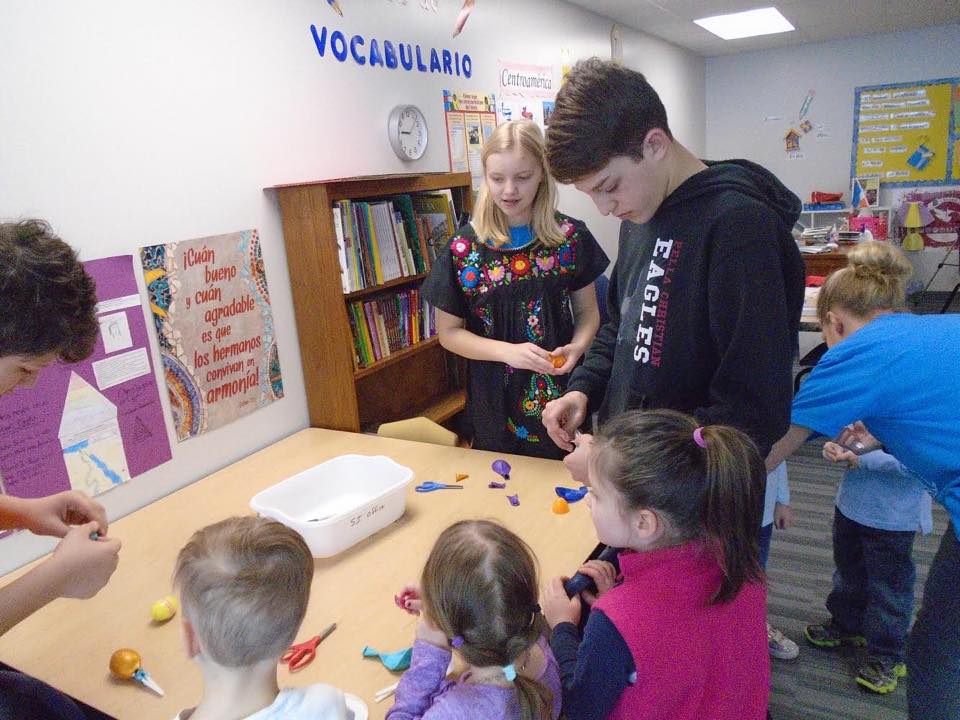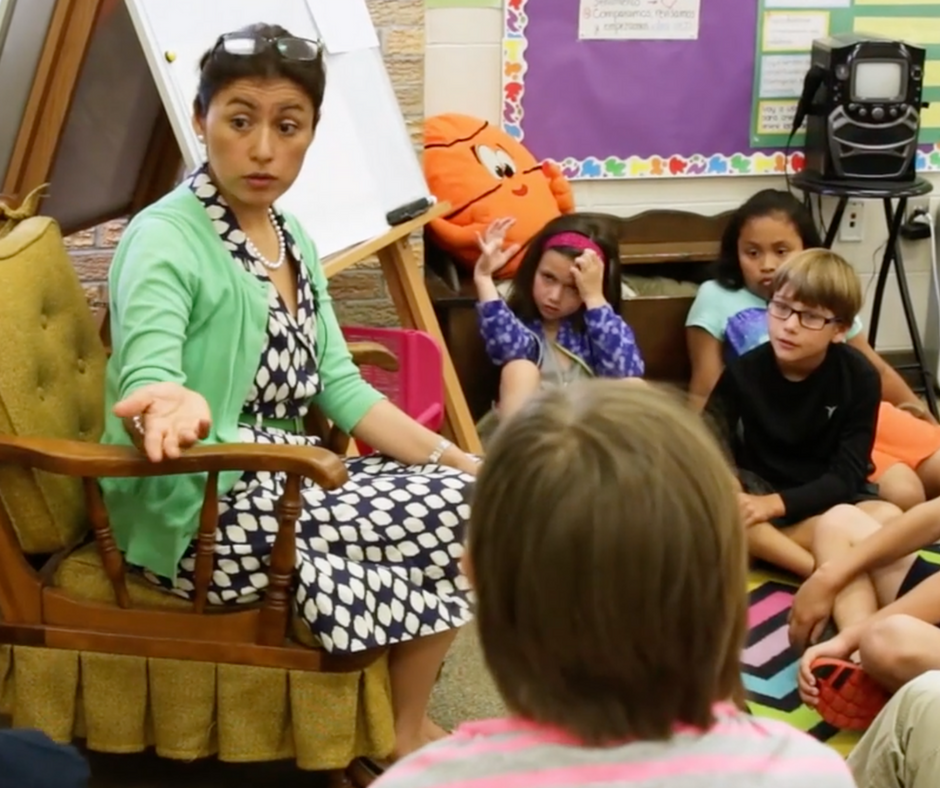Copyright 2025 © All rights Reserved.

The Czech proverb,
“As many languages you know, as many times you are a human being.”
perfectly summarizes the reason we dedicated the last twenty plus years to dual language and immersion education.
We believe that multiplying the number of languages students acquire while in school might also multiply the number of opportunities they have to experience being human.
But what defines “being human” or the “human experience?”
Many experts agree, what sets our experience apart from other living things is our ability to feel a wide range of emotions and to empathize. To empathize means we can imagine and identify with the thoughts and feelings of others. The experts also agree that empathy is so important because it can lead to compassion. Compassion, in turn, can lead to taking action for the good of others, a vital part of society and community.

What does language have to do with empathy?
Though all humans are born with the capacity to empathize, psychologists will tell you that empathy is a learned behavior that needs to be developed. For most humans, language development goes hand in hand with emotional and cognitive development. Just read two essays written by the same student, one from kindergarten and one from twelfth grade and you’ll see what we mean. If one language increasingly expands the ways in which students can express and interpret their own and others’ thoughts and emotions, what does developing two languages do? As former educators and school leaders in Spanish dual language immersion schools, we had the privilege of observing hundreds of students “do school” in two languages.

Does developing two languages increase empathy?
Many research studies point to this possibility, but we observed it. Our students seemed to take in new information and consider it from different perspectives. They wrote stories showcasing characters with complex feelings and insights. They also seemed to develop friendships characterized by differences rather than similarities. They showed interest in people who dressed in non-western clothes and spoke different languages, smiling and turning toward such groups during field trips. It was as if our students were expanding their capacity to not simply empathize, but to empathize globally, across linguistic, cultural and ethnic differences.
What happens if the societally powerful language takes over?
But what we had observed in the early years, became less apparent as students moved into upper primary and middle school grades. We began to wonder if the change had something to do with a shift in the way students were using Spanish and English. Whenever possible they used English, the societally dominant language, to interact with content and one another. Even students who entered the program as balanced bilinguals or as Spanish-dominant participated in what we began calling “English take-over.”
We questioned whether or not we were unconsciously, or even consciously sending the message that English was more valuable than Spanish. Our program design meant English instructional time increased dramatically beginning in third grade and continued through secondary. Instruction involved extensive preparation for state standardized testing in English and less focus on Spanish language development. In fact, many teachers believed that students should respond as much as possible in English, even during Spanish instructional time.


What did we learn and do?
As we reflected, we wondered why our program design and instructional practice favored English. After all, research on dual language immersion student outcomes in the United States showed that academic achievement in English wasn’t the issue, minority language proficiency was. Dual language immersion student outcomes on standardized measures in English were similar to or better than that of their peers in traditional educational programs. Minority language proficiency on the other hand was concerning, as it was characterized by grammatical errors and anglicized syntax (structure).
Based on research, we began developing and implementing program guidelines, instructional frameworks and tools underpinned by teaching practices that allotted more time and energy to Spanish language development. While English outcomes didn’t waiver, Spanish proficiency increased. Though only anecdotal, teachers also recounted stories that pointed to a resurgence of global empathy. Determined to expand our vision further, we left our roles and founded addalingua, an organization dedicated to empowering teachers to inspire global empathy through dual language and immersion education.
Through addalingua we had the privilege of establishing long term relationships with a cohort of schools across the country. Since 2009, they have followed our minority language-centered approach to dual language and immersion education by upholding program standards, participating in a progression of professional learning, and implementing common Spanish instructional frameworks and resources. Because of these relationships, our approach evolved, informed by regular teacher feedback, student data, and countless hours of classroom observations. In 2020, we officially named our approach Language First. And since early 2020, we have adapted the original whole school approach specific to Spanish by making it accessible for individual educators teaching in any minority language.
By doing so, we’ve expanded our community, inviting all dual language and immersion educators to our website and into our Language First professional learning courses. So, if you believe it’s time to refocus dual language and immersion education on minority language development, join the movement to inspire global empathy! We are confident that by putting the minority Language First, you’ll transform not only your practice, but maybe even your students’ lives.
“Never doubt that a small group of thoughtful, committed people can change the world. Indeed. It is the only thing that ever has.”
– Margaret Mead
#InspireGlobalEmpathy
Here at addalingua, our mission is to inspire global empathy through education in two languages, and we work tirelessly to make this mission a reality for our partner schools. Read more about the people on our team who are creating national and international change through their unique set of experiences and passions.
Stacey has her hands in the development of program standards and instructional resources. When working with Stacey, prepare for rapid-fire communication and honest feedback. Though many clients find her intense (we prefer passionate), they also know Stacey will jump through hoops to come up with creative solutions or to resolve issues.
Stacey holds a Master’s Degree in Romance Linguistics with a focus on Second Language Acquisition from the University of Washington and a certificate in Dual Language and Immersion Education from the University of Minnesota. Besides studying, traveling, and volunteering in many Spanish-speaking countries, she has held teaching positions as adjunct faculty and delivered Spanish or world language methods courses at Seattle Pacific University, University of Washington, Hope College, and Aquinas College. Stacey also founded the first private school Spanish and Chinese dual language immersion programs in Michigan, where the program grew from 60 to 400 students.
Stacey lives by these words:
– Ludwig Wittgenstein
Lilah Ambrosi develops the systems and processes behind the addalingua core purpose – to inspire global empathy through education in two languages. Lilah sees the big picture and also the steps required to get there. When working with Lilah, you can expect her to request the executive summary, resolve inconsistencies, ask good questions, and ensure accurate formatting of all documents.
Lilah studied Spanish and bilingual education at Aquinas College and earned her M.A. in educational leadership from Western Michigan University. She taught for many years within a pioneer Spanish immersion program in West Michigan. As the program rapidly grew and began to draw regional attention, her role shifted from facilitator of learning within the classroom to school leader committed to excellence for the entire program.
Lilah lives by these words:
– Brené Brown
Addalingua ceo, Pamela Ratti, initially joined the team in the fall of 2018 as director of strategic business development with the crucial role of preparing Addalingua to scale through updating our technology and product platforms as well as fine-tuning the entire sales funnel to attract new leads. When working with Pamela, anticipate a broad spectrum of knowledge and a unique perspective on problem-solving with growth and innovation as the target end game.
Pamela received a B.A. in Economics and Spanish Literature and earned a Master’s fellowship in International Relations at the University of Miami. Principally a career CMO (chief marketing officer), Pamela dove right into her passion for international marketing by first spending eight years growing and rebranding the Intercontinental Hotels Group global loyalty program, nine years as part of the executive team that spearheaded Rosetta Stone’s IPO and global expansion, two years rebranding Neurocore, and another two years helping prime Galvanize for rapid growth. Pamela has a broad spectrum of industry knowledge from hospitality to health and wellness, but the majority of her experience has been related to forms of education: language acquisition, software engineering and data science boot camps, and multiple strategic consultant projects with leading education companies.
Pamela and her husband have four children – including young twin girls. When the whole family is together, you’ll commonly hear 4 languages at the dinner table: English, Spanish, German and Italian!
Pamela lives by these words:
– Mahatma Gandhi
Lindsay is the “go-to-girl” for our team members and the schools we work with. When working with Lindsay, expect her to organize anything you throw at her, to spot any little mistake or necessary detail, to play the right music at the right time, and to bring much needed peace and serenity to any high-stress situation.
Lindsay fostered her bilingualism and love for teaching at Grand Valley State University where she left with a major in Spanish and a minor in elementary education, as well as a graduate degree in Teaching English to Speakers of Other Languages (TESOL). She learned the ins and outs of education in two languages after spending two years teaching in the Dominican Republic and then ten years teaching in a Spanish Immersion program here in Holland, Michigan.
There is nothing more important to Lindsay than her family. She and her husband, Chad, have six children. They love music, having bonfires, and spending time by the water, especially at their cabin up north.
Lindsay lives by these words:
“We can do hard things.”
– Glennon Doyle
Jessica De Molder is addalingua’s driving force behind the development of scalable, AI-powered instructional tools designed to support dual language immersion (DLI) educators. When working with Jessica, expect a visionary who sees both the big picture and the fine details—bridging instructional goals with innovative technology to create future-forward solutions in education.
Jessica holds a B.A. in French and German Teaching, an M.A. in Second Language Teaching, and a Ph.D (abd). in Instructional Psychology and Technology. Her academic and professional career has centered on integrating research-based pedagogy with instructional design, artificial intelligence, and digital ecosystems. Over the years, she has led the development of more than 60 language learning curricula, designed and implemented learning ecosystems, and created AI-powered tools that enhance student engagement and personalize instruction.
Jessica has partnered with a wide range of organizations including the University of Utah, Michigan State University, AAC&U, Carnegie Learning, Women Tech Council of Utah, and the Hallo and Hello Plato apps. She is also the co-creator of ClearTalk, an award-winning language learning app recognized with the 2025 EdTech Breakthrough Award for Innovation in Language Learning.
Originally from France, Jessica moved to Germany as a teenager before coming to the United States for her university studies. She and her Canadian partner now live in Utah, where they’re raising four children and exploring the world—one hike, bike ride, passport stamp, or beach at a time.
Jessica lives by these words:
– Victor Hugo
Camellia Hill, CPO and founding team member at addalingua, is an EdTech strategist, instructional designer, and co-founder of DeMolder Hill Design. With over a decade of experience in instructional psychology, second language acquisition, and technology integration, Camellia leads the development of research-based, scalable solutions designed to support the unique needs of dual language immersion educators (DLI) and schools. When working with Camellia, you’ll experience a rare blend of pedagogical depth and impactful innovation.
Camellia has built digital ecosystems and certification pathways that drive program alignment, strengthen teacher development, and improve student outcomes. She led the curriculum design in over 50 languages, with a special focus on Less Commonly Taught Languages (LCTLs), and consulted across sectors to integrate backward design, gamification, and AI tools into STEM, DLI, world language, and career and technical education.. Camellia holds a B.Ed. in K-12, a B.A. in Kinesiology, an M.A. in Portuguese Pedagogy, and a M.S. in Instructional Psychology and Technology.
Camellia’s experiences across Europe, North America, and South America shape her global perspective. She and her partner have four kiddos in a home where open views are valued, norms are debunked, and curious exploration is invited as all continue to experience more nations and endless ventures alongside one another.
Camellia lives by these words:
“When we steep ourselves in sameness, we only become more startled by differentness.”
– Michelle Obama